A Reading Range- and Frequency-Reconfigurable Antenna for Near-Field and Far-Field UHF RFID Applications
Abstract
1. Introduction
2. Operational Principles and Designs
2.1. CRLH-TL-Based Zero-Phase-Shifting-Line
2.2. Capacitive Gap-Loaded Parallel Plate Line
2.3. ZPSL Loop Antenna
2.4. Reconfigurable CRLH-TL Loop Antenna
3. Near- and Far-Field Simulation and Measurements of the Reconfigurable Antenna
4. RFID Validation and Performance Comparison
5. Conclusions
Author Contributions
Funding
Institutional Review Board Statement
Informed Consent Statement
Data Availability Statement
Conflicts of Interest
References
- Wang, H.; Gong, W. RF-Pen: Practical Real-Time RFID Tracking in the Air. IEEE Trans. Mob. Comput. 2021, 20, 3227–3238. [Google Scholar] [CrossRef]
- Motroni, A.; Buffi, A.; Nepa, P.; Tellini, B. Sensor-Fusion and Tracking Method for Indoor Vehicles with Low-Density UHF-RFID Tags. IEEE Trans. Instrum. Meas. 2021, 70, 1–14. [Google Scholar] [CrossRef]
- Li, A.; Li, J.; Zhang, Y.; Han, D.; Li, T.; Zhang, Y. Secure UHF RFID Authentication with Smart Devices. IEEE Trans. Wirel. Commun. 2023, 22, 4520–4533. [Google Scholar] [CrossRef]
- Tao, B.; Wu, H.; Gong, Z.; Yin, Z.; Ding, H. An RFID-Based Mobile Robot Localization Method Combining Phase Difference and Readability. IEEE Trans. Autom. Sci. Eng. 2021, 18, 1406–1416. [Google Scholar] [CrossRef]
- Yao, Y.; Ren, X.; Liang, Y.; Yu, J.; Chen, X. Multipolarized Reader Antenna with Periodic Units Based on Electric Field Coupling for UHF RFID Near-Field Applications. IEEE Trans. Antennas Propag. 2019, 67, 5265–5271. [Google Scholar] [CrossRef]
- Li, H.; Chen, Y.; Xing, Z.; Yang, S. A Novel Printed Dual-Log-Periodic Array Antenna for UHF Near-Field RFID Applications. IEEE Trans. Antennas Propag. 2018, 66, 7418–7423. [Google Scholar] [CrossRef]
- Birwal, A.; Shakya, A.; Saurav; Kashyap, S.; Patel, K. A Compact Slot-Based Bi-Directional UHF RFID Reader Antenna for Far-Field Applications. IEEE J. Radio Freq. Identif. 2024, 8, 761–769. [Google Scholar] [CrossRef]
- Gu, X.; Geyi, W. Design of a Near-Field RFID Antenna Array in Metal Cabinet Environment. IEEE Antennas Wirel. Propag. Lett. 2019, 18, 79–83. [Google Scholar] [CrossRef]
- Michel, A.; Rodriguez Pino, M.; Nepa, P. Reconfigurable Modular Antenna for NF UHF RFID Smart Point Readers. IEEE Trans. Antennas Propag. 2017, 65, 498–506. [Google Scholar] [CrossRef]
- Xing, Z.; Li, H.; Sim, C.-Y.-D.; Li, J.; Li, Z. Study of a Multi-Loop Travelling Wave UHF RFID Near-Field Antenna. IEEE Access 2020, 8, 69829–69837. [Google Scholar] [CrossRef]
- Zhang, N.; Zhu, H.; Li, X.; Gao, G.; Qi, Z. UHF Pure Near-field RFID Reader Antenna Based on CSRR. IET Microw. Antennas Propag. 2020, 14, 634–642. [Google Scholar] [CrossRef]
- Huang, C.; Wang, C.; Zhu, J.; Tang, W. Electrically Large Segmented Dipole Array Antenna with Reflectors for UHF Near-Field RFID Applications. IEEE Trans. Antennas Propag. 2019, 67, 4280–4285. [Google Scholar] [CrossRef]
- Kizhekke Pakkathillam, J.; Kanagasabai, M. A Novel UHF Near-Field RFID Reader Antenna Deploying CSRR Elements. IEEE Trans. Antennas Propag. 2017, 65, 2047–2050. [Google Scholar] [CrossRef]
- Zeng, Y.; Chen, Z.N.; Qing, X.; Jin, J.-M. A Directional, Closely Spaced Zero-Phase-Shift-Line Loop Array for UHF Near-Field RFID Reader Antennas. IEEE Trans. Antennas Propag. 2018, 66, 5639–5642. [Google Scholar] [CrossRef]
- Singh, R.K.; Michel, A.; Nepa, P.; Salvatore, A.; Terraroli, M.; Perego, P. Compact and Wearable Yagi-Like Textile Antennas for Near-Field UHF-RFID Readers. IEEE Trans. Antennas Propag. 2021, 69, 1324–1333. [Google Scholar] [CrossRef]
- Yao, Y.; Liang, Y.; Yu, J.; Chen, X. A Broadband Near-Field UHF RFID Reader Antenna with Low Far-Field Gain. IEEE Trans. Antennas Propag. 2017, 65, 4869–4874. [Google Scholar] [CrossRef]
- Li, X.; Li, Q.; Zhu, H.; Li, Q.; Qi, Z.; Xiao, J. A Novel Near-Field UHF RFID Reader Array Antenna for Configurable Electrically Large Reading Area. IEEE Trans. Antennas Propag. 2019, 67, 6714–6723. [Google Scholar] [CrossRef]
- Wang, W.; Chen, C.; Wang, S.; Wu, W. Circularly Polarized Patch Antenna with Filtering Performance Using Polarization Isolation and Dispersive Delay Line. IEEE Antennas Wirel. Propag. Lett. 2020, 19, 1457–1461. [Google Scholar] [CrossRef]
- Cai, X.; Geyi, W. An Optimization Method for the Synthesis of Flat-Top Radiation Patterns in the Near- and Far-Field Regions. IEEE Trans. Antennas Propag. 2019, 67, 980–987. [Google Scholar] [CrossRef]
- Song, C.; Wu, Z. A Loop Antenna Array with an Enlarged Near-Field Interrogation Zone for UHF RFID Near-Field and Far-Field Applications. IEEE Antennas Wirel. Propag. Lett. 2022, 21, 1985–1989. [Google Scholar] [CrossRef]
- Wang, Y.; Fang, Y.; Liu, C.; Liu, X. A Switchable Near-Field and Far-Field Compact Antenna Based on Ferromagnetic Resonance. In Proceedings of the 2022 International Conference on Microwave and Millimeter Wave Technology (ICMMT), Harbin, China, 12 August 2022; pp. 1–3. [Google Scholar]
- Jin, X.; Liu, S.; Yang, Y.; Zhou, Y. A Frequency-Reconfigurable Planar Slot Antenna Using S-PIN Diode. IEEE Antennas Wirel. Propag. Lett. 2022, 21, 1007–1011. [Google Scholar] [CrossRef]
- Zhou, J.; Cai, J.; Chen, J.-X. Contactless Varactor-Loaded Bandwidth-Enhanced Frequency-Reconfigurable Patch Antenna. IEEE Antennas Wirel. Propag. Lett. 2024, 23, 2456–2460. [Google Scholar] [CrossRef]
- Di Paola, C.; Del Barrio, S.C.; Zhang, S.; Morris, A.S.; Pedersen, G.F. MEMS Tunable Frame Antennas Enabling Carrier Aggregation at 600 Mhz. IEEE Access 2020, 8, 98705–98715. [Google Scholar] [CrossRef]
- Subbaraj, S.; Thomas, S.B. Reconfigurable Antennas and Their Practical Applications—A Review. Radio Sci. 2023, 58, e2023RS007656. [Google Scholar] [CrossRef]
- Rene-Loxq, D.; Lafond, O.; Himdi, M.; Roy, L.; Ghaffar, F. Reconfigurable Half-Mode SIW Antenna Using Uniaxial Field Programmable Microwave Substrate Structure. IEEE Trans. Antennas Propag. 2022, 70, 11103–11108. [Google Scholar] [CrossRef]
- Zhang, W.; Li, Y.; Zhang, Z. A Reconfigurable Reflectarray Antenna with an 8 μ M-Thick Layer of Liquid Crystal. IEEE Trans. Antennas Propag. 2022, 70, 2770–2778. [Google Scholar] [CrossRef]
- Veselago, V.G. The electrodynamics of substances with simultaneously negative values of ε and μ. Sov. Phys. Uspekhi 1968, 10, 509–514. [Google Scholar] [CrossRef]
- Alibakhshikenari, M.; Virdee, B.S.; Azpilicueta, L.; Naser-Moghadasi, M.; Akinsolu, M.O.; See, C.H.; Liu, B.; Abd-Alhameed, R.A.; Falcone, F.; Huynen, I.; et al. A Comprehensive Survey of “Metamaterial Transmission-Line Based Antennas: Design, Challenges, and Applications”. IEEE Access 2020, 8, 144778–144808. [Google Scholar] [CrossRef]
- Jamlos, M.A.; Othman, N.A.; Mustafa, W.A.; Rahim, H.A.; Al-Kharasan, I.H.; Rani, K.N.A. Split Ring Resonator Array Metamaterial of Zero Index Unit Cell Configuration. In Proceedings of the 2022 5th International Conference on Engineering Technology and its Applications (IICETA), Al-Najaf, Iraq, 31 May 2022; pp. 205–211. [Google Scholar] [CrossRef]
- Thakur, A.S.; Rawat, M.; Kartikeyan, M.V. Design of an Oppositely-Oriented Circular Split-Ring Resonator-Loaded Multibeam All-Metallic Metamaterial Backward-Wave Oscillator. IEEE Trans. Plasma Sci. 2023, 51, 2625–2631. [Google Scholar] [CrossRef]
- Idris, I.H.; Muhsin, M.; Kamardin, K.; Yamada, Y. Focal Region Ray Tracing of a Negative Refractive Index Lens Antenna. In Proceedings of the 2023 IEEE International Symposium On Antennas And Propagation (ISAP), Kuala Lumpur, Malaysia, 30 October 2023; pp. 1–2. [Google Scholar] [CrossRef]
- Machac, J. Volumetric Double Negative Metamaterial Composed of Planar Resonators. In Proceedings of the 2018 IEEE/MTT-S International Microwave Symposium—IMS, Pennsylvania, PA, USA, 10–15 June 2018; pp. 30–32. [Google Scholar] [CrossRef]
- Yilmaz, H.O.; Yaman, F. Metamaterial Antenna Designs for a 5.8-GHz Doppler Radar. IEEE Trans. Instrum. Meas. 2020, 69, 1775–1782. [Google Scholar] [CrossRef]
- Caloz, C.; Itoh, T. Electromagnetic Metamaterials: Transmission Line Theory and Microwave Applications: The Engineering Approach; John Wiley-IEEE Press: New York, NY, USA, 2005; pp. 84–120. [Google Scholar]
- Lai, A.; Caloz, C.; Itoh, T. Composite Right/Left-Handed Transmission Line Metamaterials. IEEE Microw. Mag. 2004, 5, 34–50. [Google Scholar] [CrossRef]
- Sis, S.A.; Ustuner, F.; Demirel, E. EMI Reducing Interdigital Slot on Reference Planes of the PCBs. IEEE Trans. Electromagn. Compat. 2022, 64, 219–229. [Google Scholar] [CrossRef]
- Deng, Z.; Zhou, J.; Qian, H.J.; Luo, X. High Resolution Reconfigurable Phase-Tuning Line Using Self-Shielded 3-D Interdigital Capacitor. IEEE Microw. Wirel. Components Lett. 2020, 30, 605–608. [Google Scholar] [CrossRef]
- Cao, R.-F.; Li, L.; Liu, H.-W. Compact CPW Spoof Surface Plasmon Polariton Transmission Line with Interdigital Structure. IEEE Photonics Technol. Lett. 2023, 35, 1427–1430. [Google Scholar] [CrossRef]
- Huang, C.; Wang, C.; Zhu, J.; Tang, W. A Reader Antenna for UHF Near-Field RFID Applications Based on the Segment-Line Oppositely Directed Currents. IEEE Antennas Wirel. Propag. Lett. 2018, 17, 2159–2163. [Google Scholar] [CrossRef]
- Liu, W.E.I.; Ning Chen, Z.; Kai Yin, E.N.; Zeng, Y.; Qing, X. An Inductive Perforated Ground Backed Thin Electrically Large Zero-Phase-Shift Line Loop Antenna for UHF Near-Field RFID Reader. In Proceedings of the 2018 IEEE International Conference on Service Operations and Logistics, and Informatics (SOLI), Singpapore, 31 July–2 August 2018; pp. 123–126. [Google Scholar] [CrossRef]
- Wei, K.; Zhang, Z.; Feng, Z.; Iskander, M.F. A Wideband MNG-TL Dipole Antenna with Stable Radiation Patterns. IEEE Trans. Antennas Propag. 2013, 61, 2418–2424. [Google Scholar] [CrossRef]
- Pozar, D.M. Microwave Engineering, 4th ed.; Wiley: Hoboken, NJ, USA, 2012; pp. 51–56. [Google Scholar]
- Chaudhry, A.A.; Arif, J.K.; Ahmed, Z.; Chaudhary, M.A.; Ihsan, M. Bin Parameter Extraction of Composite Right/Left Handed (CRLH) Transmission Line Unit Cell Using off Resonance Method. In Proceedings of the 2017 14th International Bhurban Conference on Applied Sciences and Technology (IBCAST), Islamabad, Pakistan, 10–14 January 2017; pp. 779–781. [Google Scholar]
- Alien Technology, Alien 2 × 2 inlay ALN-9634 RFID tag, San Jose, CA, USA. Available online: https://www.alientechnology.com/products/tags/2x2/ (accessed on 20 August 2022).
- Yan, J.; Liu, C.; Liu, X.; Li, J.; Guo, H.; Yang, X. A Switchable Near-/Far-Field Reader Antenna for UHF RFID Applications. IEEE Antennas Wirel. Propag. Lett. 2018, 17, 789–793. [Google Scholar] [CrossRef]
- Wang, Z.; Dong, Y. Miniaturized RFID Reader Antennas Based on CRLH Negative Order Resonance. IEEE Trans. Antennas Propag. 2020, 68, 683–696. [Google Scholar] [CrossRef]
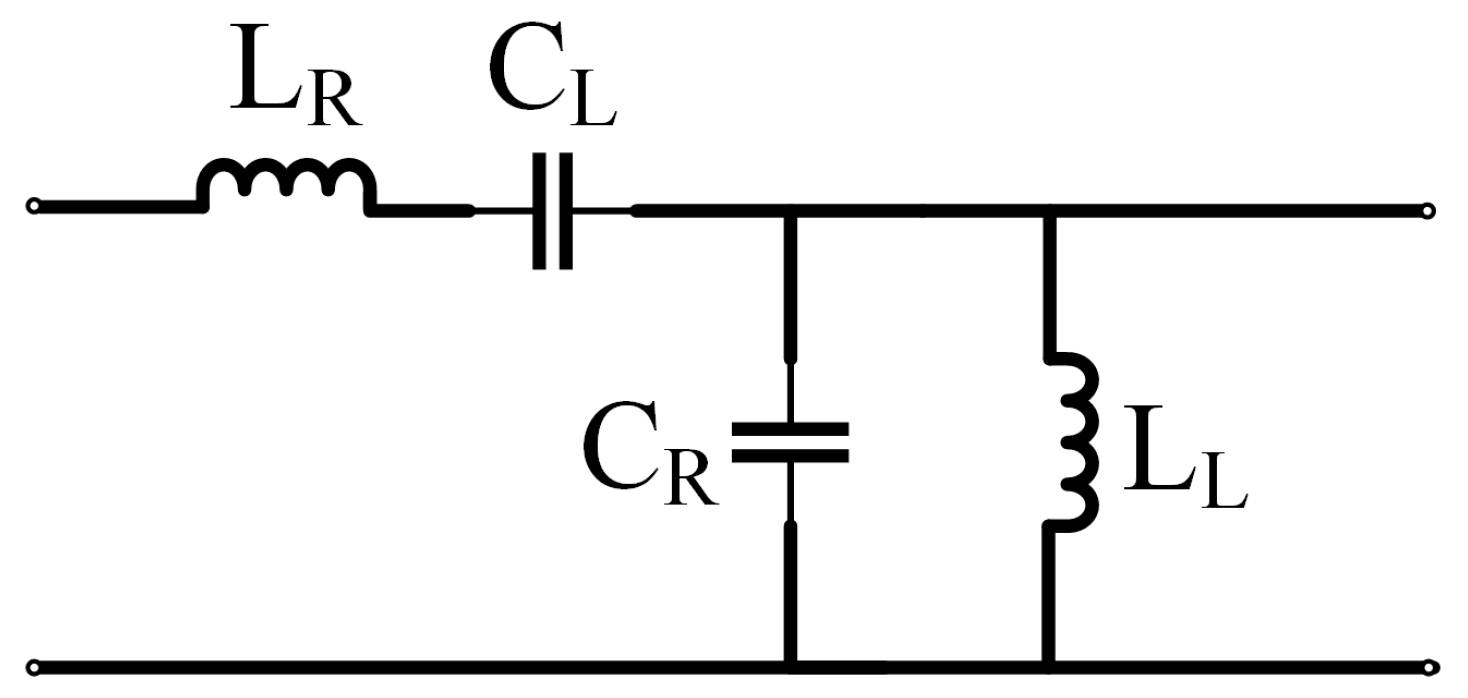



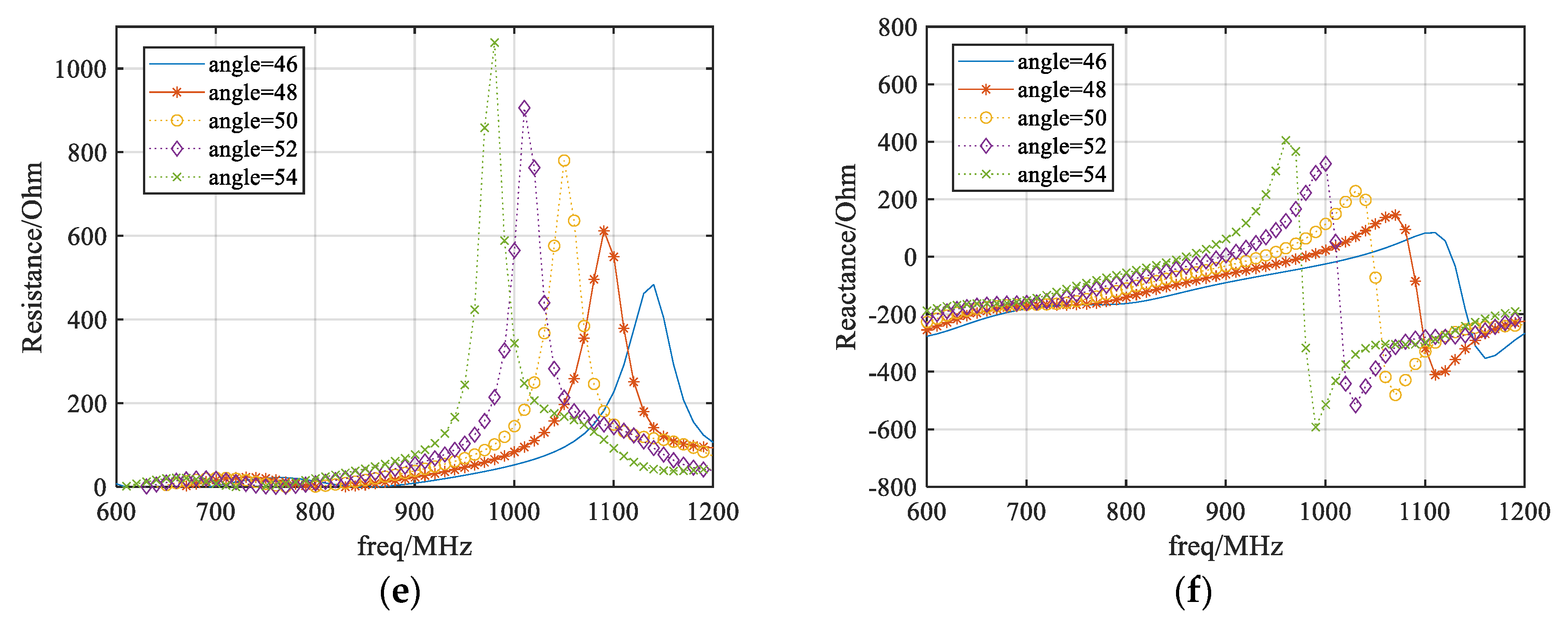





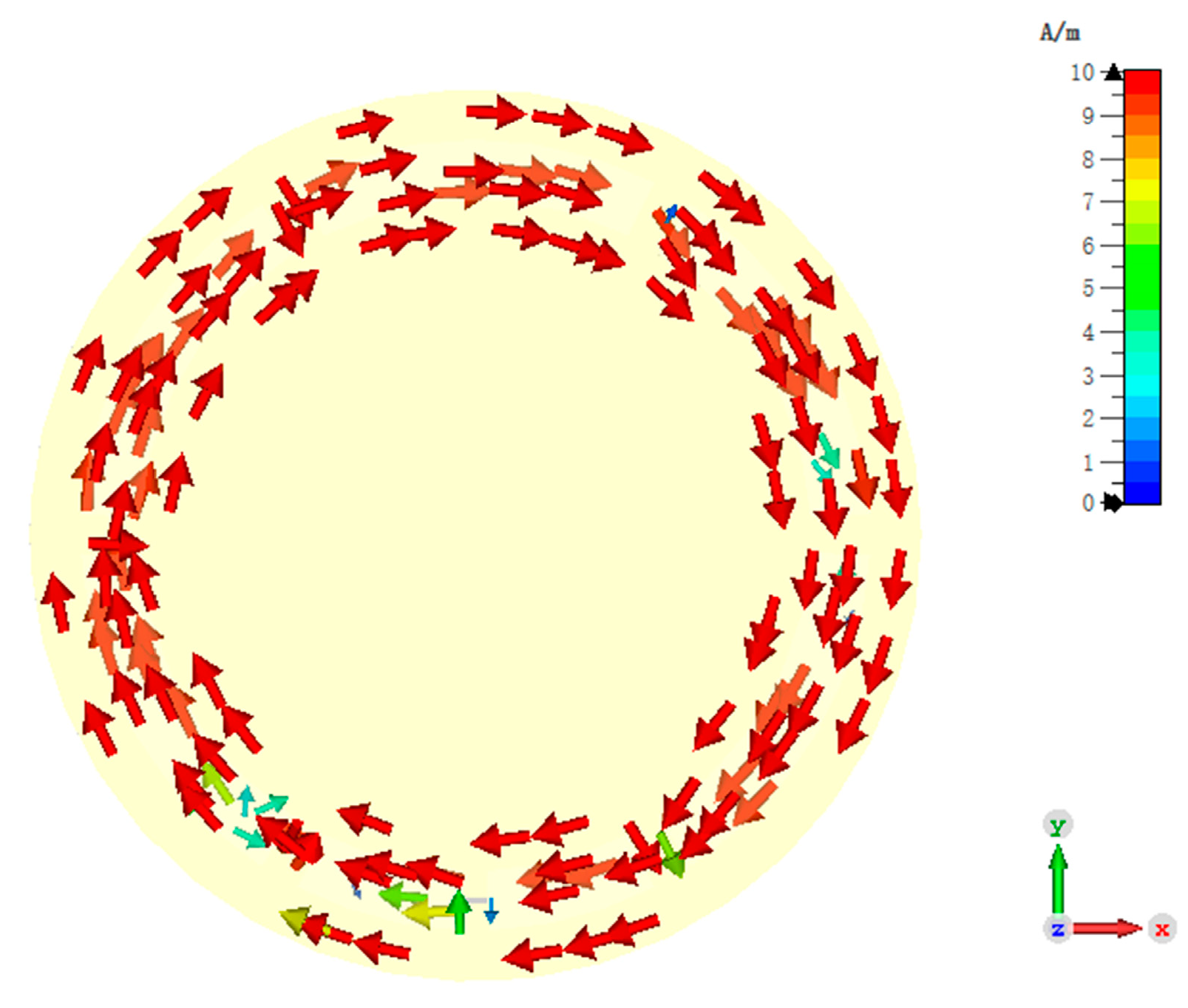
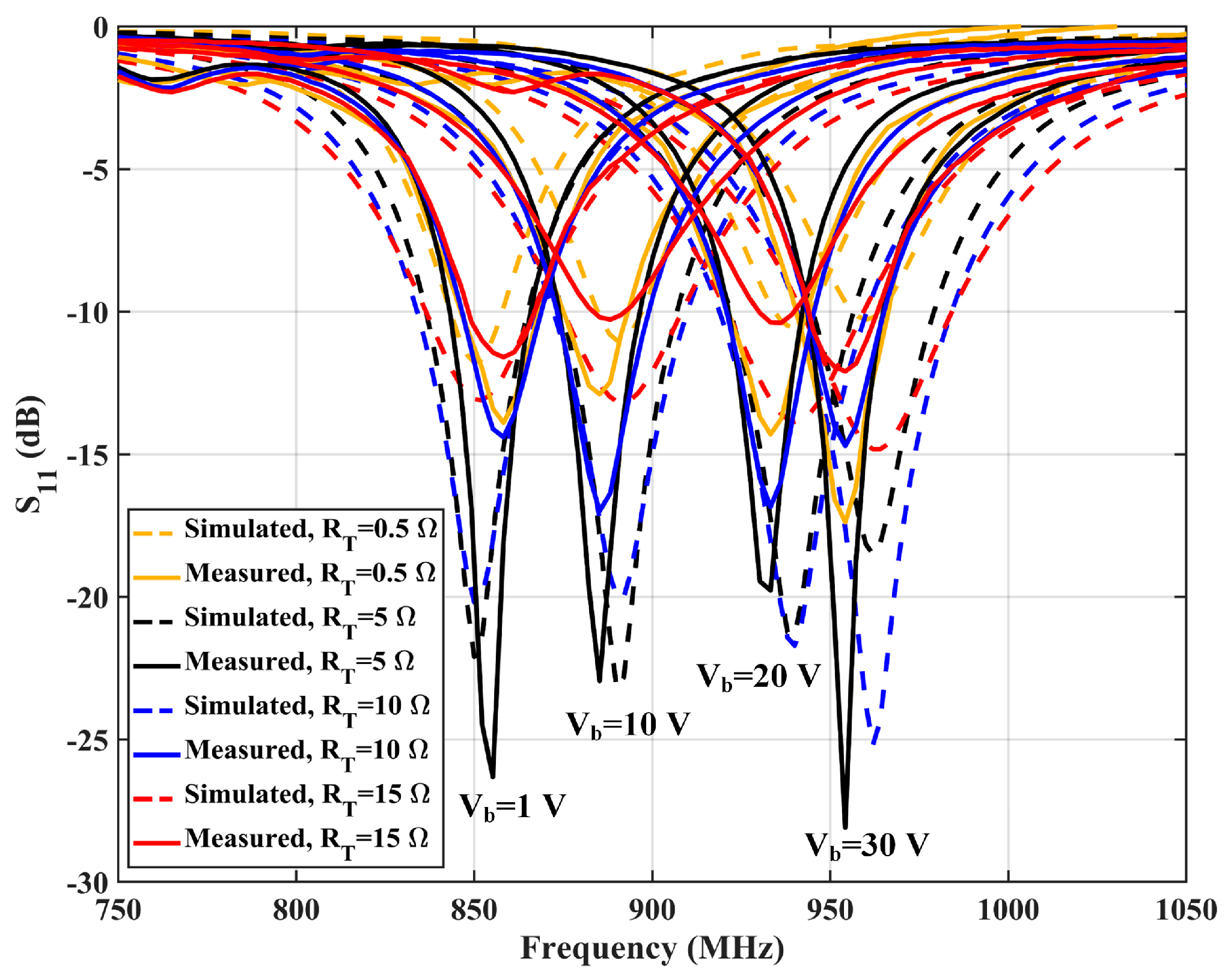
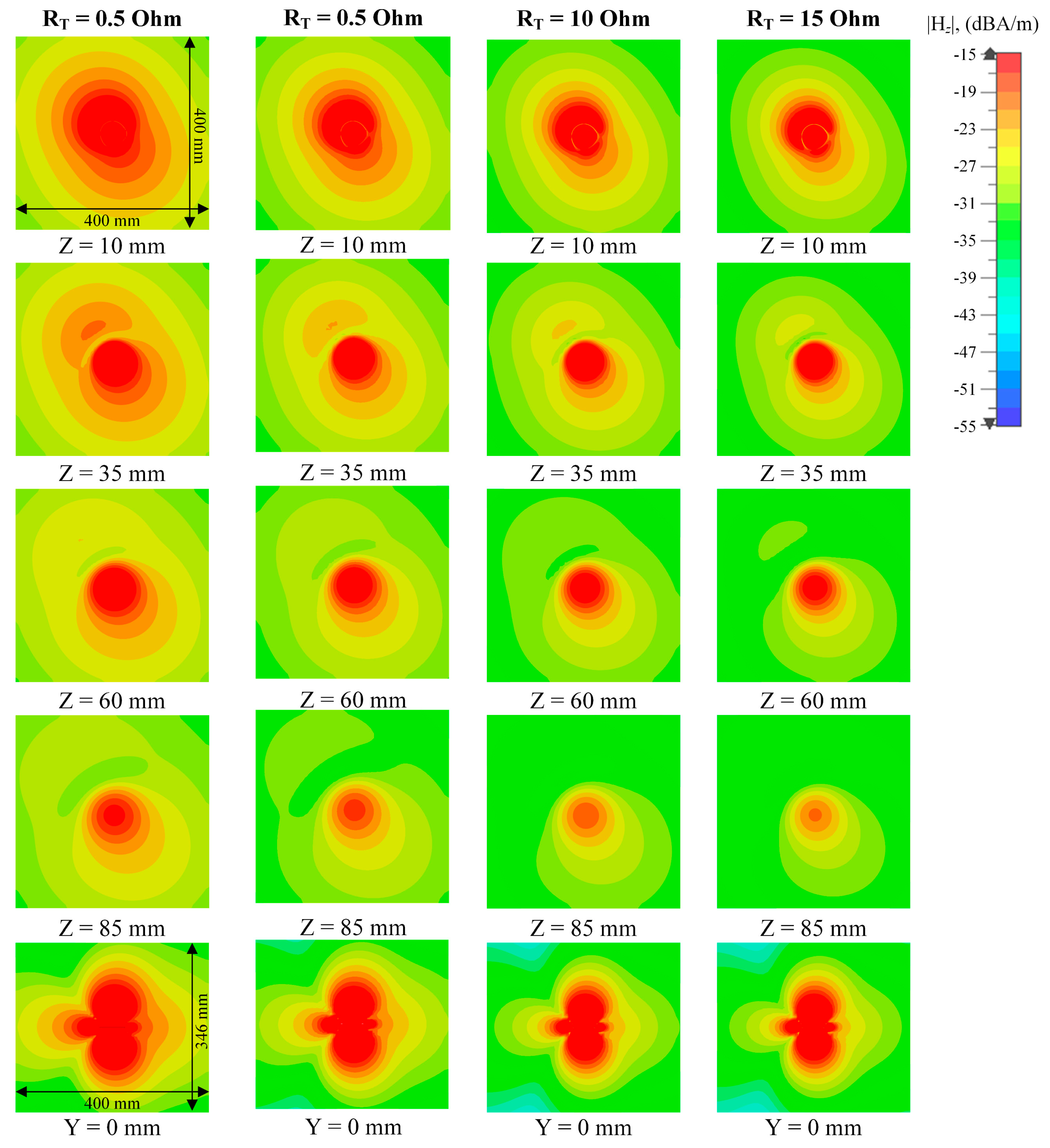



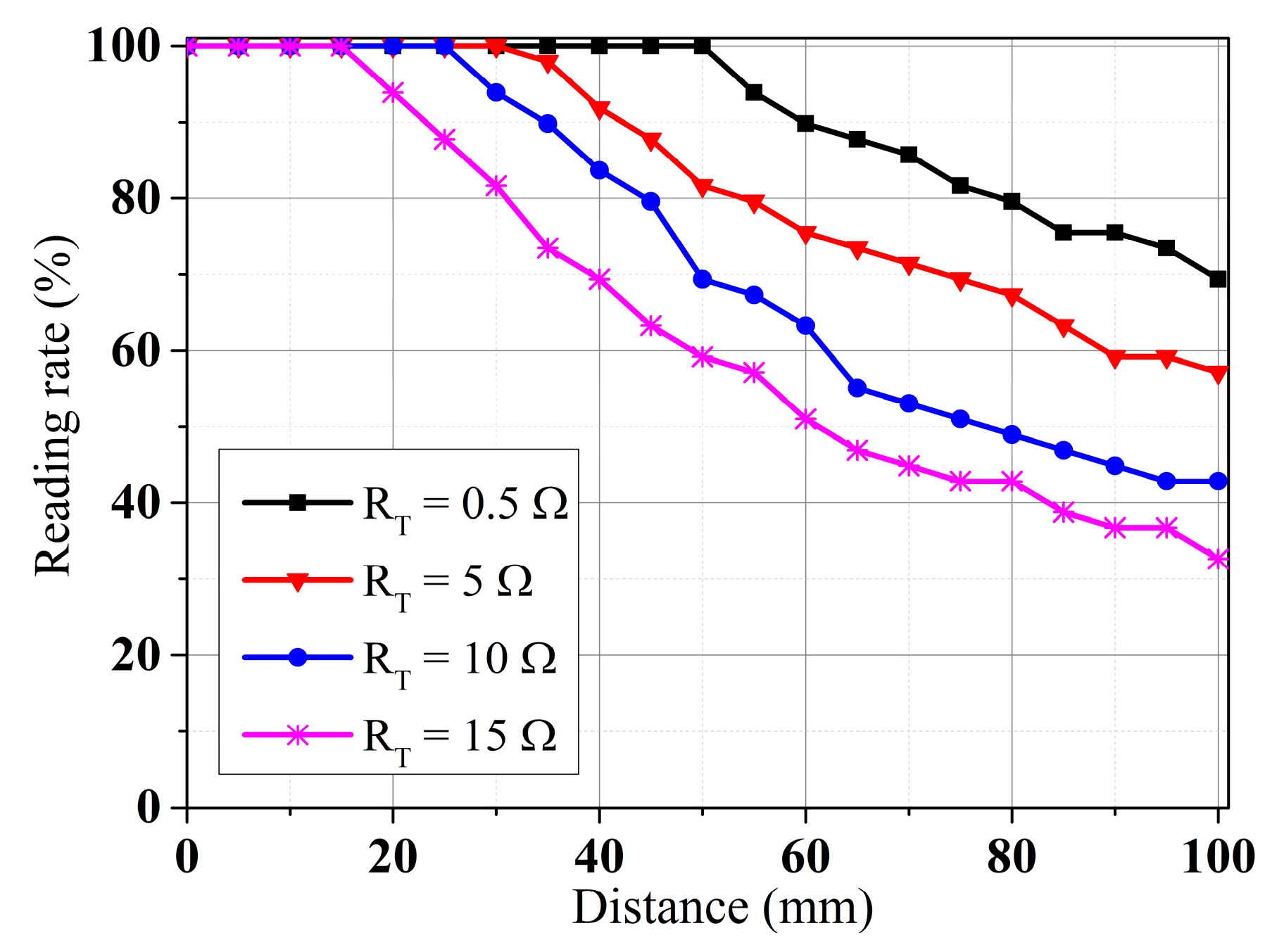

| Parameter | Description | Value |
|---|---|---|
| Dso | Diameter of the antenna | 64.5 mm |
| ro | Radius of the CRLH TL loop | 30 mm |
| wpo | Width of parallel plate line | 8 mm |
| wfo | Width of feed slot | 1.5 mm |
| luo | Length of single plate line | 12.57 mm |
| lgo | Gap length between plate lines | 3.14 mm |
| αuo | Degree of each unit | 24° |
| αgo | Degree of each gap | 6° |
| No | Number of parallel plate units | 12 |
| Parameter | Description | Value |
|---|---|---|
| Ds | Diameter of the antenna | 52.5 mm |
| r | Radius of the CRLH TL loop | 21.5 mm |
| wp | Width of parallel plate line | 3.5 mm |
| wf | Width of feed slot | 1.5 mm |
| lu | Length of single plate line | 9.0 mm |
| lg | Gap length between plate lines | 2.25 mm |
| αu | Degree of each unit | 24° |
| αg | Degree of each gap | 6° |
| N | Number of parallel plate units | 12 |
| Ref. | Methods | Bandwidth (MHz) | Purpose Field | Antenna Size (mm2) | Reading Area (mm2) | Reading Distance | FF Radiation | Gain (dBi) | Output Power (dBm) | Reconfigurability | |
|---|---|---|---|---|---|---|---|---|---|---|---|
| NF (mm) | FF (m) | ||||||||||
| [5] | Meander line | 917–937 (2.17%) | NF | 270 × 150 | 400 × 320 | 300 | n.a. | n.a. | −6 | 30 | n.a. |
| [8] | Meander line | 896–946 (5.43%) | NF & FF | 300 × 300 | 300 × 300 | n.a. | 0.6 | Directional | 3.3 | 31.5 | n.a. |
| [14] | Loop array | 896–952 (6.06%) | NF | 173.5 × 173.5 | radius = 80 | 120 | n.a. | Directional | n.a. | 30 | n.a. |
| [17] | Loop array | 913–932 (2.07%) | NF | 289 × 240 | 270 × 240 | 43 | n.a. | n.a. | −22.5 | 30 | n.a. |
| [47] | CRLH material | 869–936 (7.40%) | FF | 75 × 75 | n.a. | n.a. | 9.3 | Directional | 5.72 | n.a. | n.a. |
| [46] | Dipole array | 870–930 (6.65%) | NF or FF | 280 × 280 | 300 × 300 | 25. | n.a. | Directional | 7 | 27 | Switchable detection zone |
| This work | CRLH loop | 833–979 (16.93%) | NF & FF | 53 × 53 | 400 × 400 | 0.5 Ω mode: 50 | 2.72 | Omnidirectional | −0.6 | 30 | Frequency & detection zone |
Disclaimer/Publisher’s Note: The statements, opinions and data contained in all publications are solely those of the individual author(s) and contributor(s) and not of MDPI and/or the editor(s). MDPI and/or the editor(s) disclaim responsibility for any injury to people or property resulting from any ideas, methods, instructions or products referred to in the content. |
© 2025 by the authors. Licensee MDPI, Basel, Switzerland. This article is an open access article distributed under the terms and conditions of the Creative Commons Attribution (CC BY) license (https://creativecommons.org/licenses/by/4.0/).
Share and Cite
Song, C.; Wu, Z. A Reading Range- and Frequency-Reconfigurable Antenna for Near-Field and Far-Field UHF RFID Applications. Sensors 2025, 25, 408. https://doi.org/10.3390/s25020408
Song C, Wu Z. A Reading Range- and Frequency-Reconfigurable Antenna for Near-Field and Far-Field UHF RFID Applications. Sensors. 2025; 25(2):408. https://doi.org/10.3390/s25020408
Chicago/Turabian StyleSong, Chenyang, and Zhipeng Wu. 2025. "A Reading Range- and Frequency-Reconfigurable Antenna for Near-Field and Far-Field UHF RFID Applications" Sensors 25, no. 2: 408. https://doi.org/10.3390/s25020408
APA StyleSong, C., & Wu, Z. (2025). A Reading Range- and Frequency-Reconfigurable Antenna for Near-Field and Far-Field UHF RFID Applications. Sensors, 25(2), 408. https://doi.org/10.3390/s25020408





